In this post we will integrate Apache Tiles 3 with Spring MVC 4, using annotation-based configuration. Apache Tiles is a template based, composite view framework: it allows to reuse page pieces across the application, keeping consistent look and feel. Page layouts in general contains several page-fragments like header,footer, menu & content. In a consistent layout, only content changes between page navigation while other page fragments like header,footer & menu remains fixed most of the time.
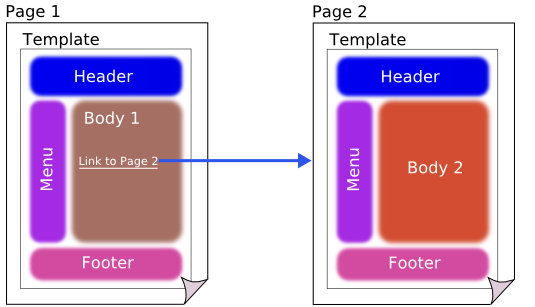
Tiles allows developers to define these page fragments which can be assembled into complete pages at run time.

- Spring Boot+AngularJS+Spring Data+Hibernate+MySQL CRUD App
- Spring Boot REST API Tutorial
- Spring Boot WAR deployment example
- Secure Spring REST API using OAuth2
- Spring Boot Introduction + Hello World Example
- AngularJS+Spring Security using Basic Authentication
- Secure Spring REST API using Basic Authentication
- Spring 4 MVC+JPA2+Hibernate Many-to-many Example
- Spring 4 Caching Annotations Tutorial
- Spring 4 Cache Tutorial with EhCache
- Spring 4 Email Template Library Example
- Spring 4 Email With Attachment Tutorial
- Spring 4 Email Integration Tutorial
- Spring MVC 4+JMS+ActiveMQ Integration Example
- Spring 4+JMS+ActiveMQ @JmsLister @EnableJms Example
- Spring 4+JMS+ActiveMQ Integration Example
- Spring MVC 4+Spring Security 4 + Hibernate Integration Example
- Spring MVC 4+AngularJS Example
- Spring MVC 4+AngularJS Server communication example : CRUD application using ngResource $resource service
- Spring MVC 4+AngularJS Routing with UI-Router Example
- Spring MVC 4+Hibernate 4 Many-to-many JSP Example
- Spring MVC 4+Hibernate 4+MySQL+Maven integration + Testing example using annotations
- Spring Security 4 Hibernate Integration Annotation+XML Example
- Spring MVC4 FileUpload-Download Hibernate+MySQL Example
- Spring MVC 4 Form Validation and Resource Handling
- Spring Batch- MultiResourceItemReader & HibernateItemWriter example
Following technologies being used:
- Spring 4.2.6.RELEASE
- Apache Tiles 3.0.5
- Maven 3
- JDK 1.7
- Tomcat 8.0.21
- Eclipse MARS.1 Release 4.5.1
Let’s begin.
Step 1: Create the directory structure
Following will be the final project structure:
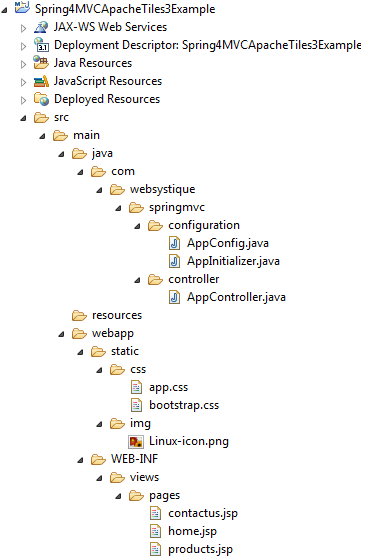
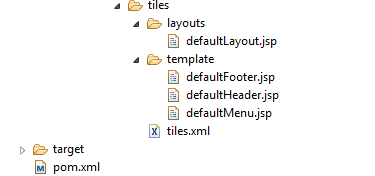
Let’s now add the content mentioned in above structure explaining each in detail.
Step 2: Update pom.xml to include required dependencies
<project xsi:schemaLocation="http://maven.apache.org/POM/4.0.0 http://maven.apache.org/xsd/maven-4.0.0.xsd"
xmlns="http://maven.apache.org/POM/4.0.0" xmlns:xsi="http://www.w3.org/2001/XMLSchema-instance">
<modelVersion>4.0.0</modelVersion>
<groupId>com.websystique.springmvc</groupId>
<artifactId>Spring4MVCApacheTiles3Example</artifactId>
<packaging>war</packaging>
<version>1.0.0</version>
<name>Spring4MVCApacheTiles3Example</name>
<properties>
<springframework.version>4.2.6.RELEASE</springframework.version>
<apachetiles.version>3.0.5</apachetiles.version>
</properties>
<dependencies>
<!-- Spring -->
<dependency>
<groupId>org.springframework</groupId>
<artifactId>spring-core</artifactId>
<version>${springframework.version}</version>
</dependency>
<dependency>
<groupId>org.springframework</groupId>
<artifactId>spring-web</artifactId>
<version>${springframework.version}</version>
</dependency>
<dependency>
<groupId>org.springframework</groupId>
<artifactId>spring-webmvc</artifactId>
<version>${springframework.version}</version>
</dependency>
<!-- Apache Tiles -->
<dependency>
<groupId>org.apache.tiles</groupId>
<artifactId>tiles-core</artifactId>
<version>${apachetiles.version}</version>
</dependency>
<dependency>
<groupId>org.apache.tiles</groupId>
<artifactId>tiles-api</artifactId>
<version>${apachetiles.version}</version>
</dependency>
<dependency>
<groupId>org.apache.tiles</groupId>
<artifactId>tiles-servlet</artifactId>
<version>${apachetiles.version}</version>
</dependency>
<dependency>
<groupId>org.apache.tiles</groupId>
<artifactId>tiles-jsp</artifactId>
<version>${apachetiles.version}</version>
</dependency>
<!-- Servlet+JSP+JSTL -->
<dependency>
<groupId>javax.servlet</groupId>
<artifactId>javax.servlet-api</artifactId>
<version>3.1.0</version>
</dependency>
<dependency>
<groupId>javax.servlet.jsp</groupId>
<artifactId>javax.servlet.jsp-api</artifactId>
<version>2.3.1</version>
</dependency>
<dependency>
<groupId>javax.servlet</groupId>
<artifactId>jstl</artifactId>
<version>1.2</version>
</dependency>
</dependencies>
<build>
<pluginManagement>
<plugins>
<plugin>
<groupId>org.apache.maven.plugins</groupId>
<artifactId>maven-compiler-plugin</artifactId>
<version>3.2</version>
<configuration>
<source>1.7</source>
<target>1.7</target>
</configuration>
</plugin>
<plugin>
<groupId>org.apache.maven.plugins</groupId>
<artifactId>maven-war-plugin</artifactId>
<version>2.4</version>
<configuration>
<warSourceDirectory>src/main/webapp</warSourceDirectory>
<warName>Spring4MVCApacheTiles3Example</warName>
<failOnMissingWebXml>false</failOnMissingWebXml>
</configuration>
</plugin>
</plugins>
</pluginManagement>
<finalName>Spring4MVCApacheTiles3Example</finalName>
</build>
</project>
Apart from usual Spring dependencies, We have also added few dependencies for Apache Tiles 3. Additional dependencies can be added for more advanced tiles usage. Maven Apache-tiles page lists all the dependencies from basic to advanced usages.
Step 3: Configure Tiles
Configure tiles in Spring Application configuration file.
package com.websystique.springmvc.configuration;
import org.springframework.context.annotation.Bean;
import org.springframework.context.annotation.ComponentScan;
import org.springframework.context.annotation.Configuration;
import org.springframework.web.servlet.config.annotation.EnableWebMvc;
import org.springframework.web.servlet.config.annotation.ResourceHandlerRegistry;
import org.springframework.web.servlet.config.annotation.ViewResolverRegistry;
import org.springframework.web.servlet.config.annotation.WebMvcConfigurerAdapter;
import org.springframework.web.servlet.view.tiles3.TilesConfigurer;
import org.springframework.web.servlet.view.tiles3.TilesViewResolver;
@Configuration
@EnableWebMvc
@ComponentScan(basePackages = "com.websystique.springmvc")
public class AppConfig extends WebMvcConfigurerAdapter{
/**
* Configure TilesConfigurer.
*/
@Bean
public TilesConfigurer tilesConfigurer(){
TilesConfigurer tilesConfigurer = new TilesConfigurer();
tilesConfigurer.setDefinitions(new String[] {"/WEB-INF/views/**/tiles.xml"});
tilesConfigurer.setCheckRefresh(true);
return tilesConfigurer;
}
/**
* Configure ViewResolvers to deliver preferred views.
*/
@Override
public void configureViewResolvers(ViewResolverRegistry registry) {
TilesViewResolver viewResolver = new TilesViewResolver();
registry.viewResolver(viewResolver);
}
/**
* Configure ResourceHandlers to serve static resources like CSS/ Javascript etc...
*/
@Override
public void addResourceHandlers(ResourceHandlerRegistry registry) {
registry.addResourceHandler("/static/**").addResourceLocations("/static/");
}
}
Highlights of above configurations are TilesConfigurer & TilesViewResolver. TilesConfigurer simply configures a TilesContainer using a set of files containing definitions, to be accessed by TilesView instances. Definition files are basically XML files containing layout definitions.
In our Spring MVC application, we also need a ViewResolver. Spring comes with a Tiles specific ViewResolver named TilesViewResolver. Once configured, the view names returned from your controller methods will be treated as tiles view and Spring will look for a definition having the same name in definitions XML files.
Step 4: Create tiles definitions
Shown below is the definition file tiles.xml
<?xml version="1.0" encoding="UTF-8" ?>
<!DOCTYPE tiles-definitions PUBLIC "-//Apache Software Foundation//DTD Tiles Configuration 3.0//EN" "http://tiles.apache.org/dtds/tiles-config_3_0.dtd">
<tiles-definitions>
<!-- Base Definition -->
<definition name="base-definition"
template="/WEB-INF/views/tiles/layouts/defaultLayout.jsp">
<put-attribute name="title" value="" />
<put-attribute name="header" value="/WEB-INF/views/tiles/template/defaultHeader.jsp" />
<put-attribute name="menu" value="/WEB-INF/views/tiles/template/defaultMenu.jsp" />
<put-attribute name="body" value="" />
<put-attribute name="footer" value="/WEB-INF/views/tiles/template/defaultFooter.jsp" />
</definition>
<!-- Home Page -->
<definition name="home" extends="base-definition">
<put-attribute name="title" value="Welcome" />
<put-attribute name="body" value="/WEB-INF/views/pages/home.jsp" />
</definition>
<!-- Product Page -->
<definition name="products" extends="base-definition">
<put-attribute name="title" value="Products" />
<put-attribute name="body" value="/WEB-INF/views/pages/products.jsp" />
</definition>
<!-- Contact-us Page -->
<definition name="contactus" extends="base-definition">
<put-attribute name="title" value="Contact Us" />
<put-attribute name="body" value="/WEB-INF/views/pages/contactus.jsp" />
</definition>
</tiles-definitions>
In above definition file, we have defined a base-definition and several other definitions extending base-definition. Other defintions are just overwriting the part they are specialized for. template attribute in definition-block is used to specify the actual layout file. Each of the definition (by name) can be treated as a tiles-view.
Step 5: Create Layouts
In our case we have defined a basic layout [/WEB-INF/views/tiles/layouts/defaultLayout.jsp] pinned with definition using template attribte.
defaultLayout.jsp
<%@ page language="java" contentType="text/html; charset=ISO-8859-1" pageEncoding="ISO-8859-1"%> <%@ page isELIgnored="false" %> <%@ taglib prefix="c" uri="http://java.sun.com/jsp/jstl/core"%> <%@ taglib uri="http://tiles.apache.org/tags-tiles" prefix="tiles"%> <html> <head> <meta http-equiv="Content-Type" content="text/html; charset=ISO-8859-1"> <title><tiles:getAsString name="title" /></title> <link href="<c:url value='/static/css/bootstrap.css' />" rel="stylesheet"></link> <link href="<c:url value='/static/css/app.css' />" rel="stylesheet"></link> </head> <body> <header id="header"> <tiles:insertAttribute name="header" /> </header> <section id="sidemenu"> <tiles:insertAttribute name="menu" /> </section> <section id="site-content"> <tiles:insertAttribute name="body" /> </section> <footer id="footer"> <tiles:insertAttribute name="footer" /> </footer> </body> </html>
This layout file provides the consistent look-n-feel across your application. If you want to change layout, define a corresponding layout file and attach to the definition using template attribute.
As you can see, we have a header,footer,menu & body. We are using tags-tiles tag library to provide the placeholder within layout file. Attributes specified using insertAttribute will be provided by corresponding definition(or the one extending it).
Step 6: Create views
We have created some default views[used when the extending definition does not overwrite them] and some specific ones.
defaultHeader.jsp
<div>
<h1>Tiles Demo</h1>
</div>
defaultFooter.jsp
<div> Made in this world. </div>
defaultMenu.jsp
<nav>
<a href="${pageContext.request.contextPath}/"><img class="logo" src="${pageContext.request.contextPath}/static/img/Linux-icon.png"></a>
<ul id="menu">
<li><a href="${pageContext.request.contextPath}/">Home</a></li>
<li><a href="${pageContext.request.contextPath}/products">Products</a></li>
<li><a href="${pageContext.request.contextPath}/contactus">Contact Us</a></li>
</ul>
</nav>
home.jsp
<h2>Welcome to Home page</h2>
products.jsp
<h2>Products page</h2>
contactus.jsp
<h2>Contact Us Page</h2>
Step 7: Create Controller
package com.websystique.springmvc.controller;
import org.springframework.stereotype.Controller;
import org.springframework.ui.ModelMap;
import org.springframework.web.bind.annotation.RequestMapping;
import org.springframework.web.bind.annotation.RequestMethod;
@Controller
@RequestMapping("/")
public class AppController {
@RequestMapping(value = { "/"}, method = RequestMethod.GET)
public String homePage(ModelMap model) {
return "home";
}
@RequestMapping(value = { "/products"}, method = RequestMethod.GET)
public String productsPage(ModelMap model) {
return "products";
}
@RequestMapping(value = { "/contactus"}, method = RequestMethod.GET)
public String contactUsPage(ModelMap model) {
return "contactus";
}
}
Look at each of these controller methods. The returned value from them is treated as tiles-view [Thanks to TilesViewResolver] and corresponding tiles-definition gets consulted.
Step 8: Create Initializer
package com.websystique.springmvc.configuration;
import org.springframework.web.servlet.support.AbstractAnnotationConfigDispatcherServletInitializer;
public class AppInitializer extends AbstractAnnotationConfigDispatcherServletInitializer {
@Override
protected Class<?>[] getRootConfigClasses() {
return new Class[] { AppConfig.class };
}
@Override
protected Class<?>[] getServletConfigClasses() {
return null;
}
@Override
protected String[] getServletMappings() {
return new String[] { "/" };
}
}
Step 9: Build, deploy and Run Application
Now build the war (either by eclipse as was mentioned in previous tutorials) or via maven command line( mvn clean install). Deploy the war to a Servlet 3.0 container . Since here i am using Tomcat, i will simply put this war file into tomcat webapps folder and click on startup.bat inside tomcat/bin directory.
If you prefer to deploy from within Eclipse using tomcat: For those of us, who prefer to deploy and run from within eclipse, and might be facing difficulties setting Eclipse with tomcat, the detailed step-by-step solution can be found at : How to setup tomcat with Eclipse.
Open browser and browse at http://localhost:8080/Spring4MVCApacheTiles3Example/

Click on different menu items to see the content gets changes while preserving the actual look-n-feel.
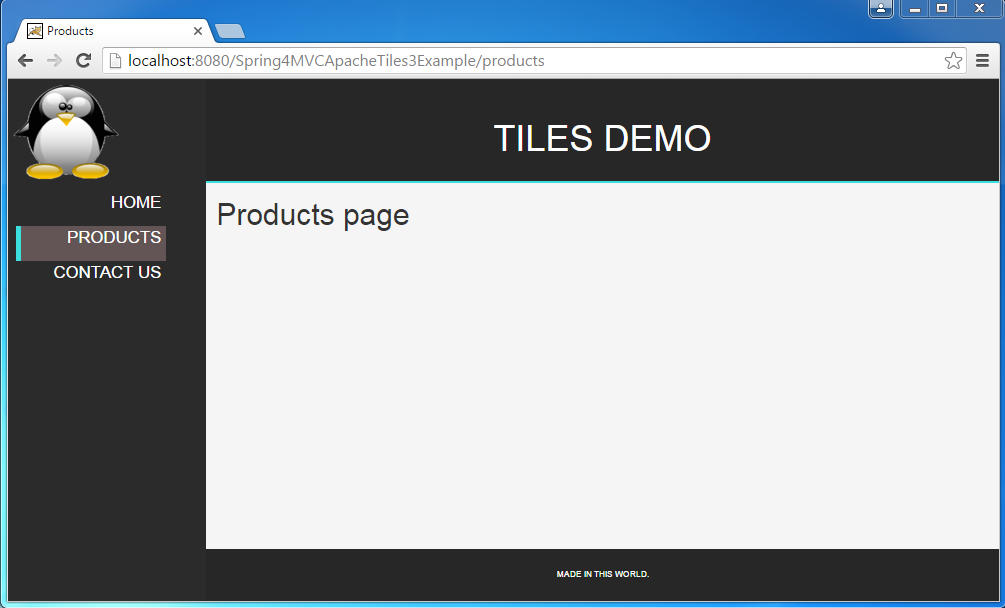
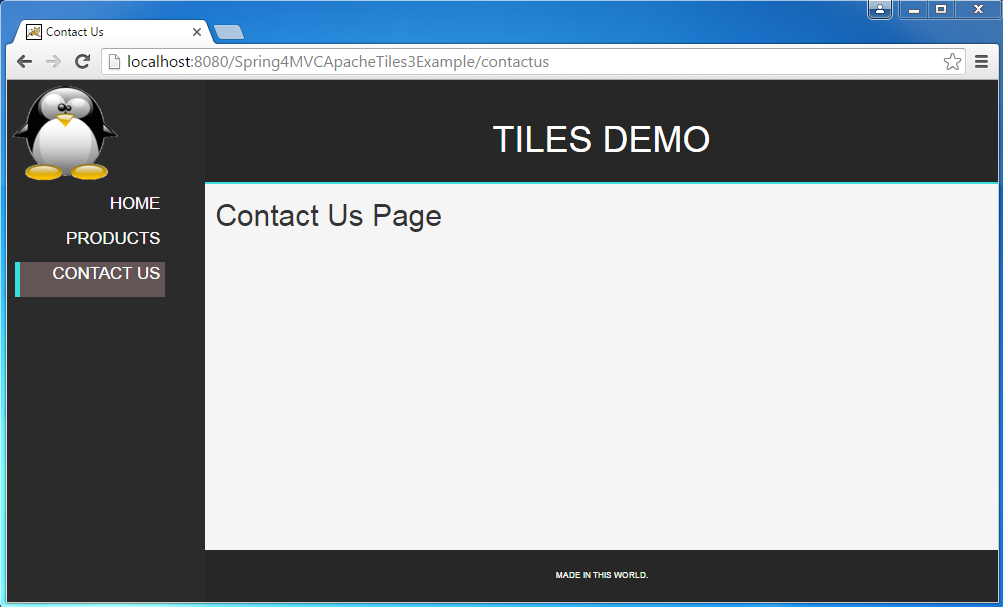
Download Source Code
References
If you like tutorials on this site, why not take a step further and connect me on Facebook , Google Plus & Twitter as well? I would love to hear your thoughts on these articles, it will help improve further our learning process.